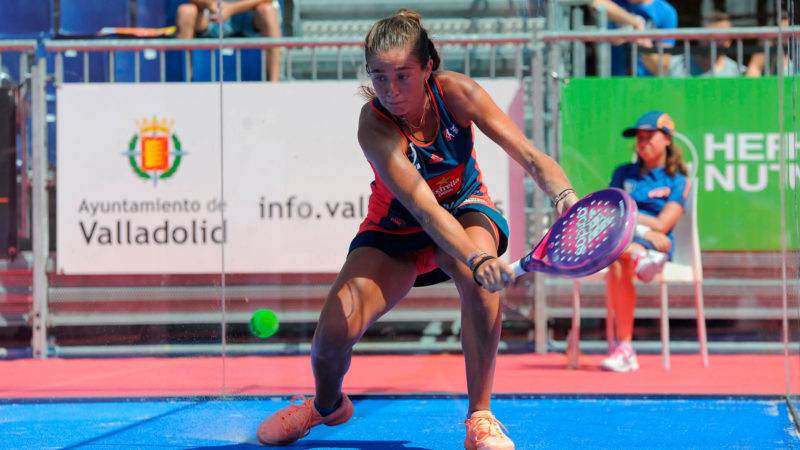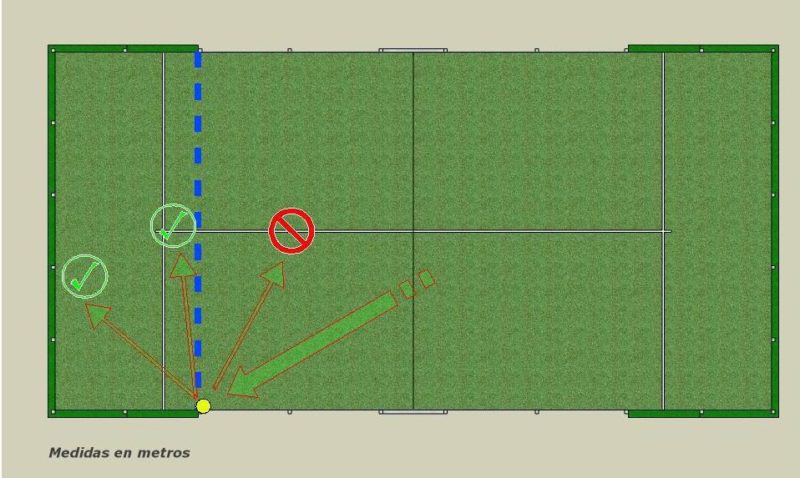
Many times while playing padel, we encounter situations where we have a doubt: was that ball a fault or not?
The official rules of padel can be found here, but the situations described below tend to cause confusion and debate even in professional tournaments, so it’s worth revising them and knowing how to act if the situation arises.
Let’s have a look and attempt to clarify some of the most common doubts that padel players face.
Case 1 – The ball bounces right in the angle between the back wall and the ground. Was it out or in?
This is known as huevo in Spanish, which means egg. I’m not sure why that is so, but that’s what it’s called. In order to understand whether it was in or out, we need to consider the angle of the trajectory taken by the ball after its bounce. If the ball’s trajectory forms a 45 degree angle or bigger with the ground, then it is considered in, while if it bounces off closer to the ground then it was out. It’s quite logical really, just applying the laws of physics.
Case 2 – We serve and the ball bounces on the ground and then rebounds off the part between the mesh and the side wall, called pico in Spanish, and border in English.

If the ball rebounds in the direction of the receiver, then it’s a valid serve, if not it is a bad serve. This is a rule that is very often confused at beginner level, and it is commonly given as a let. This is incorrect, and the rule just described should apply instead. It has to be either a good or bad serve, and never a let.
Case 3 – We run up to the net to return a ball, and we don’t manage to break fast enough and touch the net by mistake.
The net cannot come into contact with our bodies or rackets at any point during the match, hence we automatically lose the point in this case.
Case 4 – In the attacking position, close to the net, we hit the ball while our racket is in our opponents’ side of the court.
Whether it’s a valid point or not depends on the situation:
- If the ball hasn’t yet crossed to our side of the court, then it’s not a valid point and play is stopped as this is an infraction of the rules.
- If the ball has crossed to our side, rebounded against the walls and is heading back towards our opponents’ side, then we are free to invade our opponents’ court with our racket to return the ball. It is important not to touch the net while doing so.
Case 5 – In our attacking position, we hit the ball on our side of the court but subsequently our racket invades the opponents’ side of the court due to swing inertia.
It’s valid, keeping in mind that we can at no point in time touch the net with our racket or any part of our body or clothing.
Case 6 – We serve and the ball bounces more than one time in the receiver’s box.
It’s a valid point for the server as the receiver cannot let the ball bounce twice in his side of the court.
Case 7 – We serve while stepping on the imaginary central line that there is from the center of the court till the end of our side of the court.
It’s a bad serve as we cannot invade the other side of the court while serving, nor step on the imaginary line.
Unfortunately many amateur players do this and even insist that it’s allowed. No doubt, seeing professionals do it and not being sanctioned encourages this kind of nonsensical behavior.
Here’s an example from a tournament in 2019, a quarter final no less. Agustin Silingo, a top player, repeatedly serves illegally in a very clear way, and has the audacity to pretend that he didn’t know what the problem was when the referee faults him on one of his illegal serves.
Case 8 – When serving, we bounce the ball inside the box.
This is a bad serve, since we should bounce and hit the ball outside of the box. Keep in mind that you cannot step on the box’s back line either.
Case 9 – We serve and the ball bounces on the serving line or the center line of the receiver’s box.
It’s a valid serve, the lines are included in the receiving box area.
Case 10 – The ball bounces on our side and rebounds off the fence at the back of the court, above the glass wall.
The ball remains in play, there are no issues. However you cannot bounce the ball off this part off the fence yourself, as you would when bouncing the ball off the back wall to return it.
Case 11 – We hit a high ball, or globo, and the ball hits the ceiling.
Play stops and a point is awarded to your opponents. The same thing happens if the ball hits the floodlight or any other external object.
Case 12 – While returning the ball I carry it. Instead of the usual hitting the ball, there is that extra moment or two of contact between the racket and the ball, as I accompany the ball instead of hitting it. This is typical of balls that end up very close to the back wall after a lob, or during the execution of a chiquita, or during a dropshot.
The point is valid. Check this video of Bela doing an incredible dropshot:
This is the excerpt from the official rules in Spanish:
Regla 14, Punto g), Reglamento FIP: Devolución correcta.
Si se “acuchara” o se empuja la pelota se considerarà correcta la devoluciòn siempre que el jugador no la haya golpeado dos veces, el impacto se efectùe durante un mismo movimiento y no varìe sustancialmente la salida natural de la pelota.
Do you have any other questions or doubts about padel points? Let me know and I’ll add more Q & As.

Hola Jean. Two questions! My 16yr old son is convinced that so long as his feet are behind the service line and on his side of the court that the point he can hits the ball for the serve can not only be from inside the service box (which I agree with), but also beyond the half court dividing line (which I don’t agree with). Please help us with these.
The second question from a match I played this morning. Our opponent managed to hit an angled shot just over the net and which bounced in line with the net post and the fence upright and out the door. We didn’t know whether it was in or out and allowed him the point because it was on the same surface as the rest of the court. However if I was to draw a straight line along the bottom of the fence through the net the ball would have been out. I couldn’t find any help on this online. Any thoughts? Thank you.
Hola Saverio.
First question: Your son is right, as long as the bounce also happens behind the service line and on his side of the court (same rule as the feet), then he can serve in the way you describe. This usually means reaching in with the upper part of one’s body. Totally legal.
Second question: Usually the court color and the outside color are different, or even different surfaces, so we look at which surface the ball bounced on. From what you describe, the surface color and type was the same outside the court (perhaps for outside play) but the ball bounced outside the imaginary continuous line of the fence, in which case it would be out.
What happens when a ball falls out of the player’s pocket or the hat falls off?
Say i return a ball, but hit it with my hand holding the racket, a point is made, is that allowed?
No, can’t touch the ball with anything else apart from the racket.
What if I’m receiving the ball from the server and touch the ball before hit the ground and we are confused if it out the box or in ?
That will always be a point for the server. You need to let the ball bounce once before returning.
If my team mate and i went for the ball, i hit the ball and he hits my racket does the point get canceled.
It says that a carry is legal, but a carry often is a ball touching the racket more than once. Is that legal?
From what I recon the ball can hit the racket multiple times as long as it is in one continous motion. Correct?
Serve cases:
How many tries of serve is given in these cases?
Case 1: First try is net, Second try is net..is a 3rd try given?
Case 2: First try is net, Second try is fault..is a 3rd try given?
Case 3: First try is fault, Second try is net…is a 3rd try given?
Case 4: serve hits directly the glass or fence of opponent instead of hitting the ground..is that considered a fault or a point loss?
In defense at volley ball touches the racquet and the hand on the grip, lobs and win point.
Is this a valid point?
If a serve is long and I return it, does this mean I’ve accepted it as a good serve.
Interesting stuff. Thanks.
Although very improbable, is it allowed to “climb” or run up a wall to return a shot?
Yes and I’ve seen it done. Keep the imaginative situations coming 🙂
Hi, there is a small continuation line after the service line (in the center), not sure if it is on all padel courts. When serving and the ball lands on that continuation line, is this in or out ? My assumption is “out” since it does not really belong to surrounding line of the receiver’s box, but some say it is “in”.
Out.
Hi,
Earlier today we had a discussion during our game. Opponent smashed appropriate (first ground, then glass behind us and by returning he bounced twice on top of the fence before falling down, i returned the ball (without the ball touching the ground on our side, is this a correct play?
Thanks in advance!
Yes, that would be a valid play from your end. Play would only stop if the ball touches a foreign object (such as the club’s ceiling if playing indoors, or the floodlights).
Hi Jean,
On our court we have a vertical net above the back wall, in order to prevent balls from getting to other courts. So starting from the bottom of the back wall, we have glass, then fence, then the net. What if while smashing we hit the ground (of course) and then hit the net? Can the opponent still return the ball or is the point stopped? What makes it extra interesting: only one of the two back walls has such a net, the other one doesn’t (so the ball would go out of court on the side without net). Thanks in advance for your response! I love this blog with all the interesting cases.
Hi, here is a fictional situation: if your opponent smashes the ball and it hit your glass and is on its way back to their court, can you enter their side of the court to make a point? Or say you jump onto their court, without your feet tochung the ground and hut the ball into their net. Is that valid?
kind regards
You guys are getting very creative 🙂 It would ultimately be a fault as by the time the ball would have bounced twice you would surely have landed on the other side of the court and that would be an invasion. The rule states that you cannot touch any part of the opponents’ court, and at that point you would have violated that rule.
No I jumped and hit the ball into the net and it touched the net and opponent’s ground before my feet land in his ground?